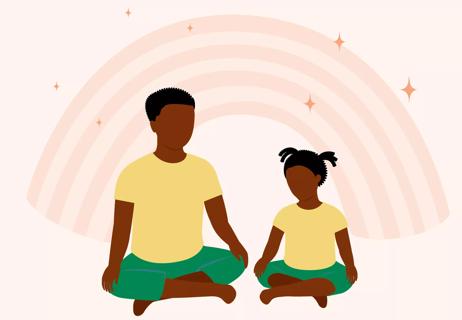Immersing yourself in nature can improve both your mental and physical health

Many people enjoy spending time in nature. But did you know that time among the trees could be therapeutic? Forest therapy is a growing practice that promises benefits for your mind and body. Enthusiasts say it can help you relax and refuel — and give you a break from the devices, worries and stress that dominate your daily life. It might even improve your physical health.
Advertisement
Cleveland Clinic is a non-profit academic medical center. Advertising on our site helps support our mission. We do not endorse non-Cleveland Clinic products or services. Policy
Forest therapy is rooted in the Japanese practice of shinrin-yoku, which is often translated as “forest bathing.” But it’s not a literal bath. The term refers simply to immersing yourself in the atmosphere of the forest.
But forest therapy is more than just a meander through the woods. Trained forest therapy guides help participants engage in activities that help them experience the natural environment with all of their senses.
Walking through forests isn’t a new practice, but the concept of shinrin-yoku is. It’s only been around since 1982. It’s based on three different traditional concepts: yūgen, komorebi and wabi sabi.
“The intent of forest bathing is to put people in touch with present-moment experience in a very deep way,” explains clinical psychologist Susan Albers, PsyD. “The sights, sounds and smells of the forest take us right into that moment, so our brains stop anticipating, recalling, ruminating and worrying.”
Advertisement
If you think that sounds like mindfulness, you’re right.
“Mindfulness is the practice of being in the present moment with intention, without judging,” Dr. Albers adds. “Forest therapy involves noticing and sensing things rather than judging or evaluating them.”
Common sense says that taking in the sights and sounds of the forest can help you relax. But it’s possible that time in the great outdoors could boost more than just your mental health. It may be good for your body, too.
Shirin-yoku has only been around for about four decades, so it hasn’t been particularly well-researched. The evidence that it can improve your physical health is shaky at best. Most researchers conducting studies on the topic say there simply isn’t enough data to come to any firm conclusions. Still, the research that we do have is quite promising.
Let’s take a look. One 2007 study showed that forest therapy reduces cortisol, a stress hormone. Research conducted in 2010 found that people who walked in the forest twice a day for two hours (so, four hours of walking a day) had greater levels of cancer-killing proteins and immune cells.
In 2011, yet another study found that forest therapy was beneficial. It reported that shinrin-yoku had a positive impact on blood pressure and adiponectin, a protein that helps regulate blood sugar levels. But a more recent study casts doubt on some of those findings. It found that forest bathing didn’t necessarily have an impact on blood pressure, but it did reduce depression in a significant way.
Taken together, the science on forest bathing makes a convincing argument that spending time communing with nature can improve stress, anxiety and depression.
That doesn’t surprise Dr. Albers. "Forest therapy engages multiple senses,” she notes. “That sensory immersion directs attention away from negative thoughts and promotes a more positive mental state.”
But that’s not all.
“Forest therapy can have a positive impact on the oxygen levels in your brain,” Dr. Albers explains. That’s because you’re surrounded by trees and vegetation that engage in photosynthesis. The result: Plants absorb carbon dioxide and release oxygen into the air.
“The forest has higher oxygen levels compared to urban or indoor environments,” she continues. “As you breathe in the fresh air within a forest, you’re inhaling oxygen-rich air, which can support proper oxygenation of your blood and subsequently benefit your brain function.”
Forests are also chock full of phytoncides, which are antimicrobial compounds released by trees and plants.
“Inhaling these compounds during forest therapy sessions may benefit the immune system and contribute to stress reduction,” Dr. Albers says. “And the pleasant aromas of nature can have a positive impact on mood and emotional well-being.” In other words, forest therapy is also aromatherapy. Add the mental health benefits of walking to this cocktail, and you’ve got a recipe for better mental and physical health on your hands.
Advertisement
But chances are you won’t see doctors endorsing forest therapy as a cure for physical or mental health concerns any time soon. The evidence just isn’t there. But here’s the thing: It doesn’t really matter. Enjoying a few hours soaking in nature isn’t going to hurt you, and there’s a decent chance it could help. So, if you think you’d enjoy it, you should try it!
According to the World Bank, about 56% of the world’s population currently lives in urban areas. They expect the number to balloon to about 70% by 2050. It raises an important question: Are there ways for people to take advantage of forest bathing outside of forests?
At least right now, the answer is: Sort of.
A 2022 study indicates that location does matter: It found that walking in an actual forest had a greater effect on cardiovascular health than walking in a city park.
But when it comes to grounding yourself, something is always better than nothing. If you live in a big city and can’t easily get to a proper forest, Dr. Albers recommends going to your local park or green space. While it might not give you the exact same feeling as you’d get tramping through the wilderness, studies suggest walking in an urban park can improve your mood, your heart rate variability and even your memory.
Advertisement
If you don’t have access to green space at all — or if you just can’t get enough of that forest feeling — try bringing the outside in. Spruce up your space by:
While the jury’s still out on their effectiveness, you might also want to consider trying a grounding mat. It’s an electrified mat that you stand, sit or lie on to — in theory — reconnect your electric current with the earth’s. If you do decide to try out a grounding mat, read the directions carefully, and check it before each use to ensure it’s safe to operate.
Although the occasional forest therapy outing may help you unwind for a few hours, you need to engage in forest therapy regularly to really reap the benefits.
“It’s like taking a piano lesson,” Dr. Albers says. “If you never play the piano after that, the lesson doesn’t make much difference.”
Advertisement
Ideally, you should be immersed in nature for a few hours at a time, but even 15 minutes could make a difference. If that’s not doable, Dr. Albers suggests finding ways to make other mindfulness practices a part of your daily life.
“You can take the forest therapy experience and then form a brief five-minute practice every day,” she says.
Try the following practice:
“The reason we practice this is that if we find ourselves lost in thought or worry or regret at some other time, we can more easily re-center ourselves,” Dr. Albers explains. “It takes a lot of practice. Our brains have been worrying and ruminating and overthinking for many years.”
Dr. Albers says forest therapy is a great way to get started with mindfulness.
“Make mindfulness one of your daily habits,” she encourages.
Take the time to breathe deeply and turn your focus inward. If you can, get yourself outside among the trees. Leave your screens, your deadlines and your worries behind. It’s worth it — even if you can only spare a few minutes.
Learn more about our editorial process.
Advertisement

7 tips to help your child focus on the present and build lifelong coping skills

It’s often full of sugar, sodium and refined grains

Work on keeping your cool when facing daily hassles

Identify your triggers, set ground rules for your break and start practicing mindfulness

Connecting with others, going for a walk or focusing on sleep quality can help more than you might realize

Like being your own best friend in times of trouble, self-love is an act of self-preservation

Your body’s natural response to stress can lead to painful skin irritation

It’s not about embracing your dark side — it’s about showing up for yourself

Type 2 diabetes isn’t inevitable with these dietary changes

Applying a hot or cold compress can help with pain